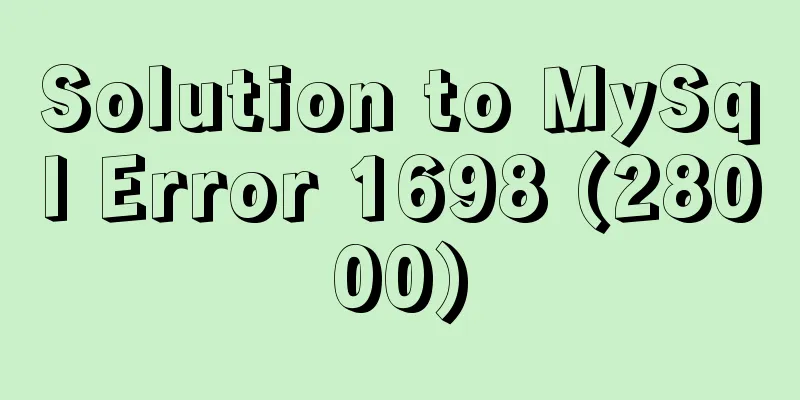A brief analysis of how to use border and display attributes in CSS

|
Introduction to border properties
The border line type attribute value description table is as follows: |
| Attributes | describe |
|---|---|
| none | Defines no border. |
| hidden | Same as "none". The exception is when applied to tables, where hidden is used to resolve border conflicts. |
| dotted | Defines a dotted border. Renders as a solid line in most browsers. |
| dashed | Defines a dashed line. Renders as a solid line in most browsers. |
| solid | Defines a solid line. |
| double | Defines a double line. The width of the double line is equal to the value of border-width. |
| groove | Defines the 3D groove border. The effect depends on the value of border-color. |
| ridge | Defines a 3D ridge border. The effect depends on the value of border-color. |
| inset | Defines the 3D inset border. The effect depends on the value of border-color. |
| outset | Defines the 3D outset bounding box. The effect depends on the value of border-color. |
| inherit | Specifies that the border style should be inherited from the parent element. |
The border direction attribute value description table is as follows:
| property | describe |
|---|---|
| border-top | Sets the top border of an element. |
| border-bottom | Sets the bottom border of an element. |
| border-left | Sets the left border of an element. |
| border-right | Sets the right border of an element. |
Border Practice
Practice code:
<!DOCTYPE html>
<html lang="en">
<head>
<meta charset="UTF-8">
<meta name="viewport" content="width=device-width, initial-scale=1.0">
<meta http-equiv="X-UA-Compatible" content="ie=edge">
<title>Border</title>
<style>
.box{
width: 200px;
height: 100px;
border: 1px solid red;
}
</style>
</head>
<body>
<div class="box">
Smile is the first belief</div>
</body>
</html>Result Plot

Note: The border color can be omitted and is black by default. If the other two properties are not written, no border will be displayed.
Setting element border direction practice
Code Blocks
<!DOCTYPE html>
<html lang="en">
<head>
<meta charset="UTF-8">
<meta name="viewport" content="width=device-width, initial-scale=1.0">
<meta http-equiv="X-UA-Compatible" content="ie=edge">
<title>Border</title>
<style>
.box{
width: 200px;
height: 100px;
border-top: 2px double red;
border-bottom: 2px ridge lawngreen;
border-left: 2px inset darkorange;
border-right:2px groove darkblue;
}
</style>
</head>
<body>
<div class="box">
Smile is the first belief</div>
</body>
</html>Result Plot

Introduction to display properties
display attribute means display. display attribute can convert inline elements to block-level elements and vice versa, setting hidden elements to display state or setting displayed elements to hidden state.
The following table describes the display attribute values:
| Property Value | describe |
|---|---|
| inline | Converts a block-level element to an inline element. |
| block | Function: 1. Convert inline elements to block-level elements. 2. Set the hidden elements to display state. |
| none | Sets a displayed element to a hidden state. |
Display property practice
Use display attribute with a value of block to set the width and height of span tag and set a background color.
Code Blocks
<!DOCTYPE html>
<html lang="en">
<head>
<meta charset="UTF-8">
<meta name="viewport" content="width=device-width, initial-scale=1.0">
<meta http-equiv="X-UA-Compatible" content="ie=edge">
<title>Convert span tags to block-level elements</title>
<style>
.box{
width: 200px;
height: 100px;
display: block;
background-color: red;
}
</style>
</head>
<body>
<span class="box">Smile is the first belief</span>
</body>
</html>Result Plot

Note: If an inline element uses display: block; it has the characteristics of a block-level element.
Use display attribute with the value inline to convert h1 tag into an inline element.
Code Blocks
<!DOCTYPE html>
<html lang="en">
<head>
<meta charset="UTF-8">
<meta name="viewport" content="width=device-width, initial-scale=1.0">
<meta http-equiv="X-UA-Compatible" content="ie=edge">
<title>Convert h1 tags to inline elements</title>
<style>
.box{
width: 200px;
height: 100px;
display: inline;
background-color: red;
}
</style>
</head>
<body>
<h1 class="box">Smile is the first belief</h1>
</body>
</html>Result Plot

Note: If a block-level element uses display: inline; it has the characteristics of an inline element.
Summarize
The above is the method of using border and display attributes in CSS that I introduced to you. I hope it will be helpful to you. If you have any questions, please leave me a message and I will reply to you in time. I would also like to thank everyone for their support of the 123WORDPRESS.COM website!
If you find this article helpful, please feel free to reprint it and please indicate the source. Thank you!
<<: Practice of realizing Echarts chart width and height adaptation in Vue
>>: An article to teach you HTML
Recommend
Detailed tutorial on installing and configuring MySQL 5.7.20 under Centos7
1. Download the MySQL 5.7 installation package fr...
A brief discussion on the font settings in web pages
Setting the font for the entire site has always b...
React antd tabs switching causes repeated refresh of subcomponents
describe: When the Tabs component switches back a...
How to create a view in MySQL
Basic syntax You can create a view using the CREA...
Implementing custom scroll bar with native js
This article example shares the specific code of ...
js to achieve the effect of dragging the slider
This article shares the specific code of how to d...
Detailed explanation of CSS text decoration text-decoration & text-emphasis
In CSS, text is one of the most common things we ...
Detailed explanation of Javascript basics
Table of contents variable Data Types Extension P...
Using Docker Enterprise Edition to build your own private registry server
Docker is really cool, especially because it'...
React implements dynamic pop-up window component
When we write some UI components, if we don't...
Basic usage of custom directives in Vue
Table of contents Preface text 1. Global Registra...
html page!--[if IE]...![endif]--Detailed introduction to usage
Copy code The code is as follows: <!--[if IE]&...
How to insert 10 million records into a MySQL database table in 88 seconds
The database I use is MySQL database version 5.7 ...
Simple operation of installing vi command in docker container
When using a docker container, sometimes vim is n...
MySQL GTID comprehensive summary
Table of contents 01 Introduction to GTID 02 How ...









